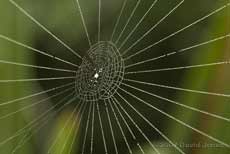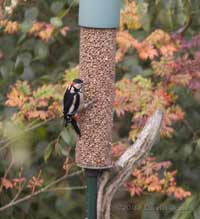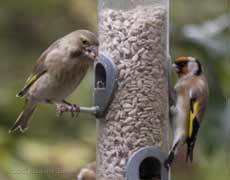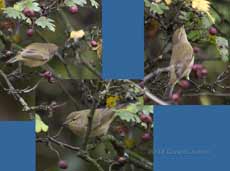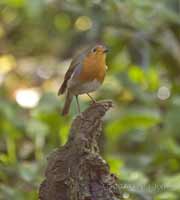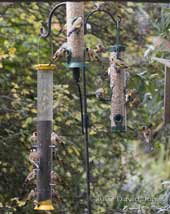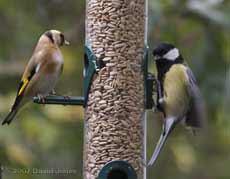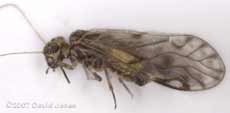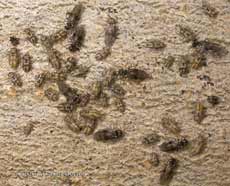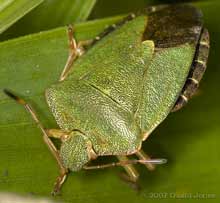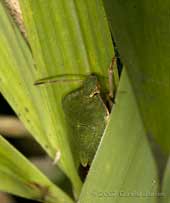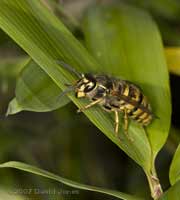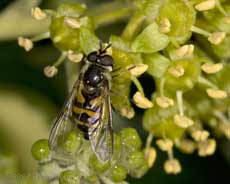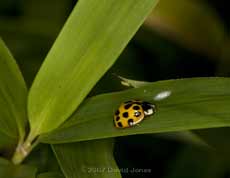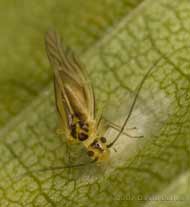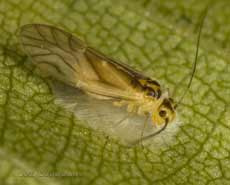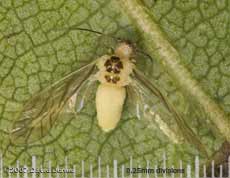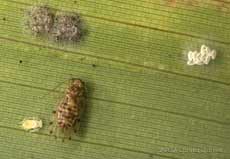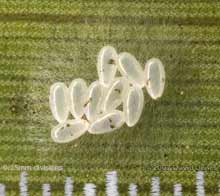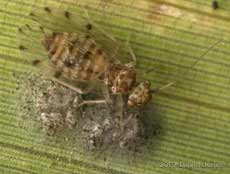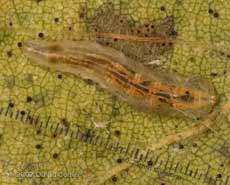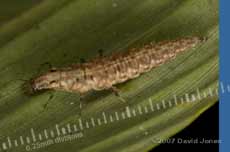Go to the last entry on this page ... ....Go to previous entry11 October - The first thick morning mists of the Autumn gave way to a pleasant day, although I'm afraid that I didn't really take advantage of it. Out at the front of the house especially, the spider webs were transformed by the moisture. This one was suspended between plants over the big pond - I wonder if it is incomplete because the mist came down while the spider was still building it? Why are there two silk strands that appear to be dry?
No barkfly pictures today, but Bob Saville has now confirmed that the barkfly I first photographed on the 8th is in fact Trichopsocus clarus. He tells me that sightings this year have indicated that it is far more widespread that previously thought, so it is not so scarce after all!
14 October - The last few days have been quite mild, but cloudy and dry most of the time, except for a bit of drizzle yesterday. This morning was dull, but it got brighter during the afternoon. The poor light during the morning was a bit annoying as it turned into one of those 'bird' days, and as a result today's pictures are not as sharp as they should be.
Then, when I happened to go into our bedroom a short time later a Great Spotted Woodpecker arrived at the tall peanut feeder (refilled yesterday after a similar visit) and stayed long enough for me to collect the camera take some pictures. As the red patch on the back of the neck indicates, this is a male - I wonder when we will see the female for the first time this winter.
After the woodpecker left I returned to watch the feeders, and after a while the Greenfinches reappeared. While there was a male about, I only managed this one image of a female.
While I watched the Woodpecker I caught a glimpse of what I thought was a warbler fly into the Hawthorn. As I watched the feeders it appeared again. It was hunting for insects amongst the foliage of the Hawthorn, stopping to peck at the undersides of leaves - I wonder if barkflies were on the menu! Thanks to Stephen Rush of Rossendale for suggesting that it is a Chiffchaff rather than the Garden Warbler which was my first inexpert thought.
As I tried to follow the Warbler's progress a Wren appeared briefly and presented itself in a perfect pose that I wasn't quick enough to capture. This Robin was a bit more obliging, although lighting was still not good enough for me to capture a sharp image.
Before lunchtime I headed for our local garden centre to stock up on sunflower kernels, and it was a good thing that I did because this afternoon our Goldfinches had visitors! Look carefully at the large version of this picture and you will be able to count 21 Goldfinches (and one House Sparrow, or at least its tail!). In fact I counted 25 Goldfinches on several occasions and I know that there were more hidden from view as they kept on coming and going - it's the largest flock we have had here for a very long time. Luckily, as well as the kernels I also bought as slightly larger feeder with six feeding stations! Several times, all twenty feeding stations on the three feeders were occupied, with at least ten other Goldfinches trying to gain access to them.
And that was without the House Sparrows (who have their own budgie seed feeder) and the members of the Tit family like this Great Tit (one of two), as well as a couple of Blue Tits and a Coal Tit.
There were also the usual Wood Pigeons and Collared Doves, but I didn't see any Dunnocks today, and the Blackbirds continue to stay at the far end of the garden, although yesterday I saw one tucking into berries on the Rowan.
19 October - A sunny day with a frosty start (but not a picturesque one) - I understand that there was an frost early yesterday as well, but I missed that one! The last few days have gone by in a bit of a blur without much photography. Although I have had a camera pointed at the feeders for much of the time, yesterday morning I missed one of those events that I would rather didn't happen in the garden. A neighbour's cat had sneaked into the garden and managed to leap up the 4ft 6in needed to grab a Goldfinch that was at one of the feeders. There was nothing I could do to save the bird and by the time I got outside the cat had gone. I have now made a barrier that I hope will deter further such attacks. It consists of a wooden hub with thin steel rods sticking out, like the spokes of a wheel. It is fitted around the steel feeder pole, is free to rotate. The rods protrude further out than any of the three feeders, but are flexible enough to be bent easily and do no damage should a cat should try to jump up at the feeders. Why on earth shouldn't cat owners be required to take responsibility for the actions of their pets... Despite that casualty, the Goldfinches continue to bring colour (and noise - I have yet to record them properly) to the garden, with at least sixteen around the feeders this afternoon. On a smaller scale, I have been taking photographs of an example of another barkfly species this afternoon.
There are two species in the genus Philotarsus, and I think this one is probably P.parviceps, a common species. Click on the picture to see five large images.
25 October - After a dry spell since my last entry, today has been overcast and damp all day, with periods of drizzle. We have had several frosty mornings, but despite the low evening temperatures the hedgehogs continue to turn up for food. This evening I spotted the first arrival at about 7.20pm. Otherwise, there has not been a lot to report in the garden during this last week. The Ivy is flowering, and I did catch a glimpse of a Red Admiral a couple of days ago. Unfortunately most of the flowers that are 'open' are on my neighbour's side of the Ivy tree. Surprisingly, over the last few days the feeders have been emptying more slowly. The Goldfinches and the Sparrows still come to feed, although there are a few less Goldfinches here at any one time (no sign of the cat having had any more success!). I'm still not seeing a Blackbird coming to the house end of the garden, but most days I see a Wren and a Dunnock. The Wood Pigeons and the Collared Doves have been turning up more often. While I really need to get out into the garden to do some tidying up before much longer, over the last couple of days I have been sorting out our log stores for the next few months.
As soon as the log was turned over the congregation started to disperse so this picture only shows some of the group. The group of large images includes one of the right hand wings of an adult that had fallen victim to a spider's web on the log. Hopefully, the wing pictures will help to confirm the identification. The logs with the largest numbers of these barkflies have now been put in a 'safe place' so that they will not end up in our log burner!
29 October - A bright and sunny day after yesterday was thoroughly wet and miserable from dawn until dusk. I spent some time sorting out the garden shed, which had become a dump for the tools and materials used in the redecorating. However, the sunshine was too much of a temptation and I did a bit of insect spotting down the West Wing during the afternoon.
First to attract my attention was this Green Shield Bug (Palomena prasina), sunning itself on a bamboo leaf. Every-so-often it would turn to expose a different part of its body to the sun's rays.
When clouds covered the sun for a short time the bug retired to the shelter of a cluster of leaves that have been bound together by silk threads - I think it was a spider's retreat.
As I photographed the bug, this wasp landed on an adjacent leaf and turned to be side-on to the sun for a couple of minutes. There are more wasps visiting the garden now than at any other time during the year, attracted by the flowering Ivy, and by the insects that also feed from them.
I haven't spent any time watching the Ivy up until now. Today I tested the roof of the log store and have decided that it is safe to stand on, so with good weather forecast for the next few days I may spend some time watching out for unusual visitors to the flowers. In the meantime, here is one of four types of hoverfly that I saw this afternoon. It may be Didea fasciata.
Looking back across to the bamboo, there was no mistaking the sight of a Harlequin Ladybird. This is a sight that has become normal in the garden, and I have decided that I will probably no longer kill the individuals that I find. Just behind the ladybird you can see a group of barkfly eggs under their silk protective covering.
Having photographed the Harlequin I decided to search the lower branches of the Birch to find an Orange Ladybird. I found one but it was very active and I decided not to try and photograph it. However, I did come across several barkflies, all of the same species, which I think is Valenzuela flavidus, although it may be. I will need to take some wing pictures to confirm the ID, but not today. This individual caught my attention because it was very busy, constructing a silk cover over a group of eggs. The barkfly produces silk from glands that are part of the Labium (a lower mouth part, with short palpi.). As I watched, the barkfly moved back and forth securing numerous silk strands in roughly parallel groups before turning to repeat the process in a different direction. On one of the large images you can just make out the iridescence of the egg cases.
The process was well under way before I spotted it. I watched for about 15 minutes before the barkfly stopped its silk production just after 4pm. Afterwards, it took up this posture astride the structure and stayed there until at least 5.30pm. At 7.30pm it had moved but was still on the same leaf.
Looking at the tree by torchlight I could see several more egg clusters on adjacent leaves. With the tree already shedding its foliage I wonder if these leaves will fall before the eggs hatch.
On the other side of the tree are a couple of barkflies (probably the same species) that have fallen victim to fungi.
There is definitely a reduction in hedgehog activity now. Over the last couple of evenings I have only seen one individual, and most of the food has been left.
30 October - Another sunny day, and clear skies tonight mean a cold night to come. This morning got off to a good start with the male Great Spotted Woodpecker turning up again. As usual the watch is now on for his partner. Also, a Wren made a rare visit to the bird table. I took advantage of the good weather to collect another load of wood for the burner., before taking some more photographs this afternoon. First, a follow-up on yesterday's barkfly pictures. It seems that egg laying on leaves that are about to fall is part of the survival strategy of V. flavidus. The eggs will remain on the leaves as they fall, over wintering at ground level before the adults fly back up into the foliage the following year to repeat the process. The wet weather early in the year had a bad effect on barkfly numbers this year as eggs were washed away, but V. flavidus has continued to do well thanks to its use of falling leaves. I am certainly finding quite a few of them here this Autumn. It is interesting to note that I am just as likely to find them and their egg clusters on the 'evergreen' plants of the garden, namely the Ivy and the bamboos. Today, the egg cluster photographed yesterday was left unattended with the nearest adult several leaves away, showing no signs of egg laying.
The other barkfly species that is found all over the garden at the moment (although far less numerous than last year) is another common species, Ectopsocus petersi. This individual on the underside of a bamboo leaf had presumably been busy egg laying over the last few days.
It's interesting to compare the silk covering on the group of eggs at the right of the previous image. Compared with the work of V. flavidus the silk cover on this cluster seems to be thin and completely random in nature. It appears that this group was the most recently laid,
Away from the barkflies two other beasties to record - first, one of several larvae of hoverflies of Syrphus sp. hoverflies, seen here on a birch leaf that is covered with the black perithecia of the mildew that spreads through the leaves each Autumn. The larva feeds on aphids which are plentiful at the moment.
Another aphid predator was found on a bamboo leaf. This one is the larva of a Brown Lacewing, an insect that I rarely see as an adult in the garden.
A note about our Orange Ladybirds. Today I spent a long time searching the foliage on the lower branches of the Birch and saw just two adults and no larvae or pupae. Last year had been a poor year for the species here, but this year has been even worst. I cannot come up with a reason for this. Although the Harlequin ladybirds are a threat to our native species, I certainly cannot blame them for their decline as it had already started before the Harlequins arrived. There have been at least two hedgehogs feeding here tonight. Click on images to see larger versions |
|
